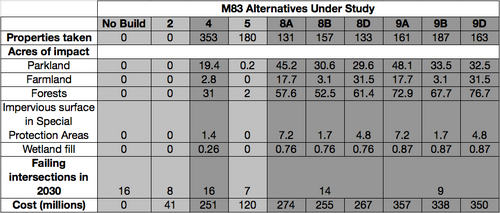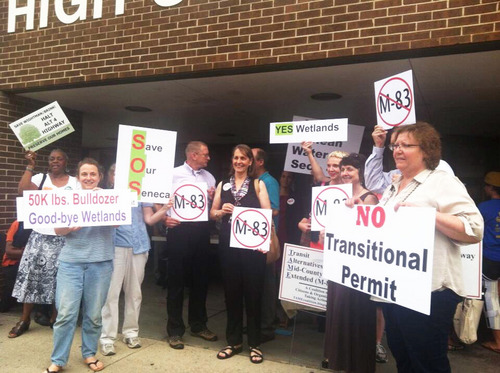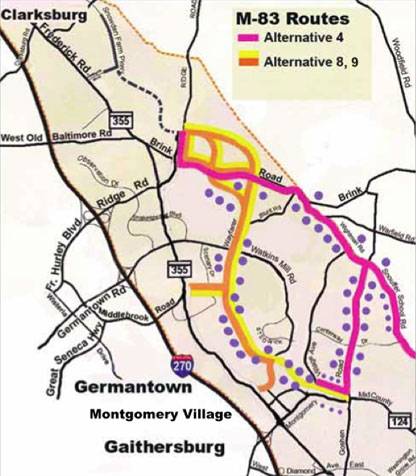Will Montgomery fund a new sprawl highway?
Montgomery County residents say the proposed Midcounty Highway between Gaithersburg and Clarksburg costs too much, cuts through sensitive park and agricultural land, and won’t solve the area’s traffic challenges. But will the county decide to build it anyway?
Midcounty Highway Extended, or M83, first showed up in area master plans in the 1960s. If built as planned, it would be a 6-lane controlled-access highway parallel to Route 355 on the east side of I-270. Montgomery County would pay for the project completely, presumably to avoid complying with stringent federal environmental regulations.
Former County Executive Doug Duncan revived the project several years ago, and the Montgomery County Department of Transportation (MCDOT) continues to push the highway forward today. MCDOT just completed an Environmental Effects Review earlier this year and will seek support from the County Council and County Executive Ike Leggett later this year to include the project in next year’s budget.
Last night, the Maryland Department of the Environment and the Army Corps of Engineers held a public hearing at Seneca Valley High School in Germantown regarding whether they should grant a joint permit to impact wetlands and streams in the highway’s path. Dozens of highway opponents from the Transit Alternatives to the Midcounty Highway Extended (TAME) Coalition, many of whom have fought the project for years, turned out in force to testify against the project. There were other voices in the crowd as well, in particular a contingent opposing the alternative through their neighborhood, but supporting the highway if it went through someone else’s backyard.
MCDOT originally evaluated 11 alternatives, and has since narrowed the field down to just 6, including a no-build option. Alternatives 4, 8, and 9 are the most controversial and involve the most new pavement and right-of-way through environmentally sensitive areas and existing neighborhoods. They also happen to be MCDOT’s preferred alternatives. MCDOT estimates that Alternative 9 would cost $350 million to build, though local activists say it could be double that.
Alternative 2, the cheapest option, would make improvements to Route 355 and use transportation demand management (TDM) to give travelers other ways to get around, while alternative 5 involves widening it. MCDOT did not look at any transit alternatives. Their report contains a footnote saying that the community requested a transit alternative, but says that the county’s Bus Rapid Transit plan is still too nascent to be considered.
MCDOT contends that new construction would impact only 0.9 acres of wetlands because they propose building bridges over and through wetland areas. Yet it is clear that the construction process to build those bridges will require filling in parts of the wetland areas and compacting their soils, which are key for filtration and other ecosystem functions. Over the long term, more pavement over wetlands means more polluted stormwater runoff into waterways already under threat from other development, such as Ten Mile Creek.

Impacts of each proposed M83 alignment. MCDOT’s favored alignments are in dark grey. TAME prefers alignments 2, 5 and the no-build option. Data from MCDOT’s executive study and traffic projections.
In addition to water quality impacts, opponents pointed out a litany of other impacts from Alternatives 4, 8, and 9, including additional carbon emissions from induced traffic, impacts to the county’s prized Agricultural Reserve, the loss of parkland, the division of neighborhoods, the taking of homes and local businesses, and more.
Local activists also questioned whether M83, if built, would even provide the traffic relief that transportation officials say it would provide. Indeed, MCDOT’s own projections show more traffic-jammed intersections if it builds any of M83’s more costly alignments.
For the $350 million it costs to build M83, Montgomery County could build Alternative 2 and 20-45 miles of the proposed bus rapid transit plan, if you use the federal average cost per mile to build BRT. This would enable a high quality transit connection and a viable alternative to driving between Clarksburg, Gaithersburg, and points south. But this alternative has never been evaluated.
Looking at the chart above, it’s easy to do the math. The county’s favored alignments destroy the most acreage of parkland, farmland, and wetlands, take the most property from local businesses and residences, cost the most, and still have more failing intersections than the cheapest, lowest impact alternatives.
Later this year, the issue will go before the County Council, and then to the County Executive, who will both have a chance to weigh in on whether to include funds to continue the project in next year’s budget. It remains to be seen whether the County leaders will continue their progressive planning tradition by investing scarce local dollars in transit and smart growth, or whether they sink hundreds of millions into a 1960’s-era sprawl highway. If they check their math, the choice should be simple.
The Maryland Department of the Environment and Army Corps of Engineers will accept written comments until August 21. If you’d like to see Montgomery County consider real alternatives to Midcounty Highway, you can contact them using this form.


